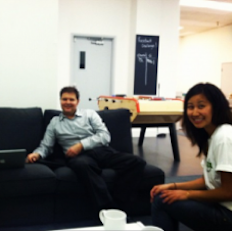SmartRecruiters recently hosted Give Labor Day at its SOMA headquarters this past Labor Day to helping less fortunate job seekers find employment. By volunteering, I was able to not only share some tips on resume writing, but also learned from other volunteers the best practices on how to strengthen a LinkedIn profile. Here are the essential resume and LinkedIn tips that volunteers shared:
The 3 Resume Essentials:
1. Fifteen Seconds and Dismiss?!
How do you get a hiring manager’s attention in 15 seconds or less? Don’t overwhelm them with text: keep your resume to two pages maximum if you have extensive experience. List 2-3 quantifiable accomplishments that speak to your strengths. Remember, you want to capture and paint a clear picture of your professional career and elaborate further in the interview. The key is to land that phone interview!
2. Remove ‘Objective’ & Add ‘Skill Sets’:
Don’t tell an employer what they can do for you; tell an employer what you can do for them! Unfortunately, before you may even get to human eyes, a computer can already eliminate you from the stack. Adding a summary of your skill sets that highlight the keywords and/or hard skills for the position will get you more callbacks.
3. Review, Review, Review!
I know many hiring managers who automatically discard a resume if they see a typo or inconsistency in organization. A resume does not only represent your achievements, but also represents skills such as writing, organization and attention to details. It’s a reflection of how you present. Always get a second pair of fresh eyes after any revision.
The 3 LinkedIn Essentials:
1. Customize your URL:
By default, LinkedIn gives you a public profile URL filled with random letters and numbers. You want to be able to give a URL that is easy for people to type, so make it as simple as linkedin.com/yourname. This makes it so you can share your LinkedIn in conversation, and it just looks cleaner in the browser. If your name is not available, be creative! You can even add a term that is industry specific if that is what your passion and future lies in (example: JohnSmithBlogger). Stay away from crazy spellings. When created, add this URL to your resume heading.
2. Summary = Story:
Feel free to write this section in the first person and give your readers a background of your past, present, future and passions. Think of this section like the first few minutes of the interview. Who are you? And what are you looking for?
3. Ask for Recommendations:
When job seeking, ask yourself the following questions: What qualities is my next company looking for? What skill sets are needed? Remember that your recommendation hinges on the position and reputation of whoever gives it. Usually, it’s best if the recommendation is from a former boss, or satisfied client, but it can also come from a respected colleague. Make sure it highlight these specific qualities and skill sets. A recommendation can act as a public reference check – the more relevant the better.
 On Give Labor Day, one of our job seekers – a personable, funny, managerial level professional – was just beginning his job search in San Francisco, where he is returning after moving internationally for 10 years. I know any recruiter would have a pleasant conversation and walk away with a wealth of knowledge on the communications industry, once they invite him in for an interview. Unfortunately, this job seeker, like many others, indicated countless applications would result in (surprise!) little to no phone calls. By sharing the tips above, job seekers can increase their likelihood of getting noticed, so they can showcase their amazing personalities and skills!
On Give Labor Day, one of our job seekers – a personable, funny, managerial level professional – was just beginning his job search in San Francisco, where he is returning after moving internationally for 10 years. I know any recruiter would have a pleasant conversation and walk away with a wealth of knowledge on the communications industry, once they invite him in for an interview. Unfortunately, this job seeker, like many others, indicated countless applications would result in (surprise!) little to no phone calls. By sharing the tips above, job seekers can increase their likelihood of getting noticed, so they can showcase their amazing personalities and skills!






